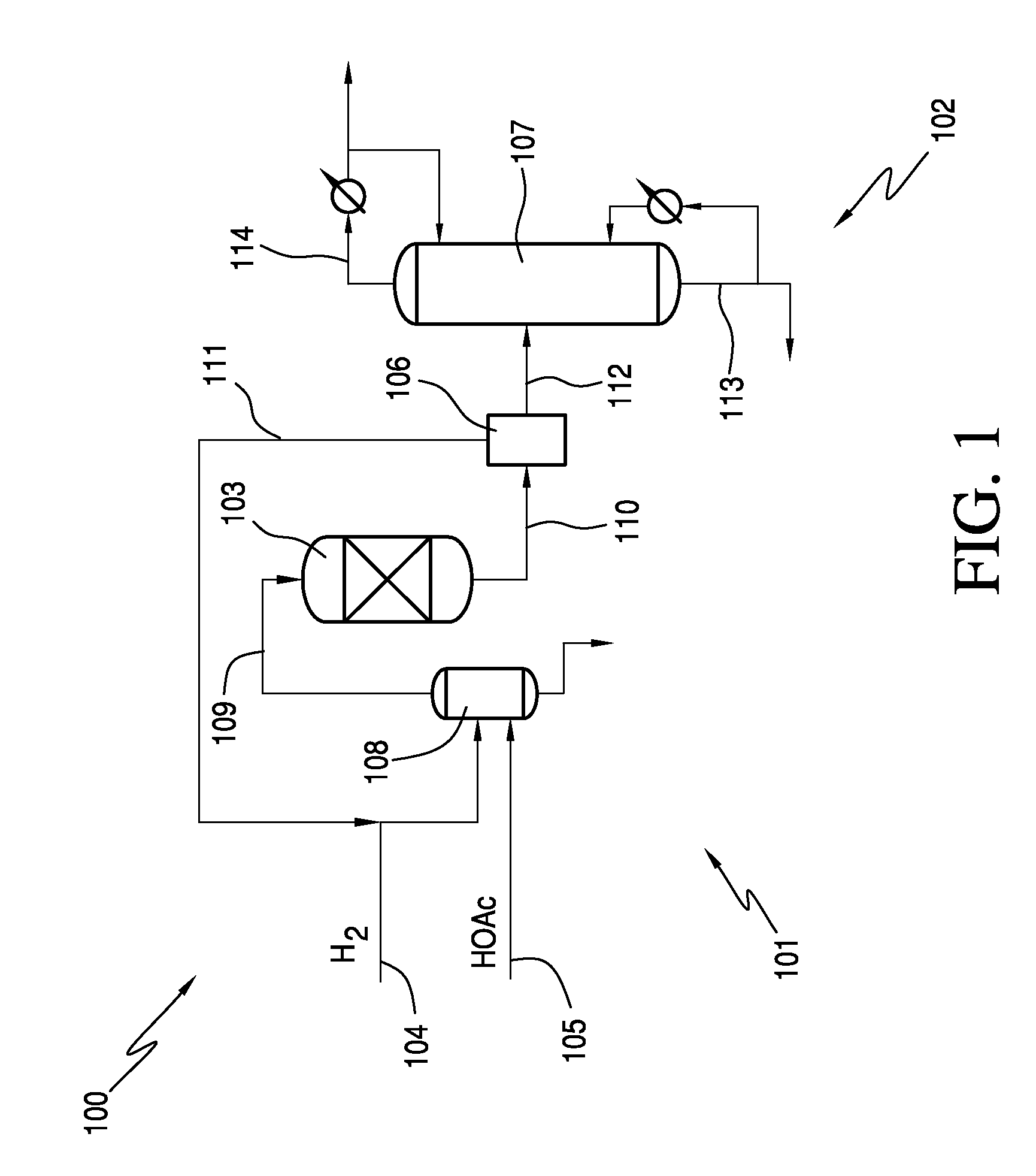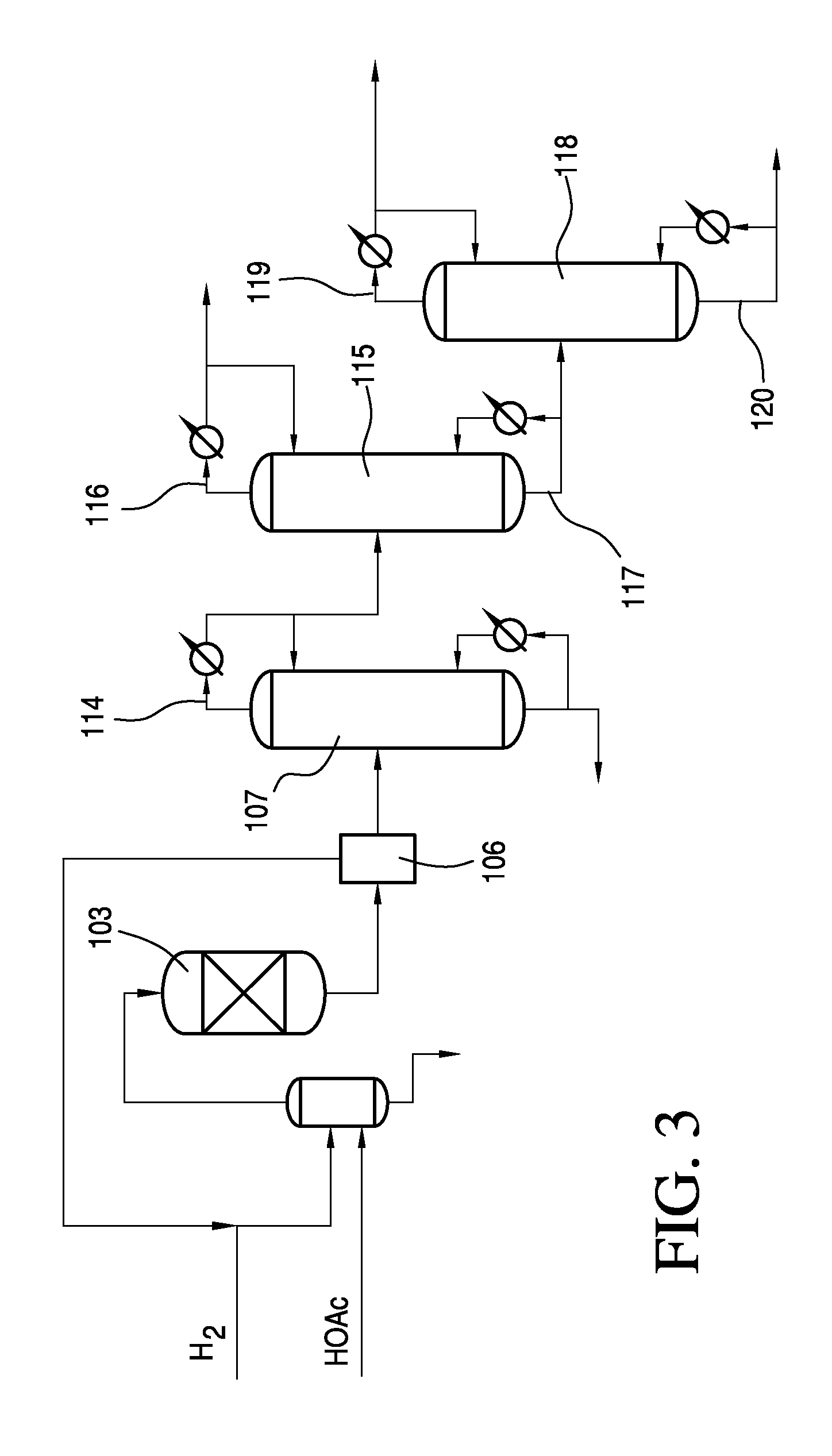Reduced Energy Alcohol Separation Process
a technology of ethanol and separation process, applied in separation process, vacuum distillation separation, oxygen-containing compound preparation, etc., can solve the problems of difficult separation, limiting the production and recovery of ethanol from such reaction mixtures, and unreacted acid remains in crude ethanol products
- Summary
- Abstract
- Description
- Claims
- Application Information
AI Technical Summary
Benefits of technology
Problems solved by technology
Method used
Image
Examples
example 1
[0108]A crude ethanol product comprising 56 wt. % ethanol, 38 wt. % water, 2 wt. % ethyl acetate, 2 wt. % acetaldehyde, 1 wt. % acetic acid, and 1 wt. % other organics was fed at 10 lbs per hour into two distillation columns in series. The first distillation column operated with 50 trays at 1 atmospheric pressure. The feed tray was located at 35th tray from the top. With reflux stream flow rate being twice of that of the distillate stream, the first column separated the feed mixture into a distillate and residue with the following compositions shown in Table 8. About 90% of the water from the crude ethanol product was removed in the residue as observed through ASPEN simulation.
TABLE 8Component (wt. %)DistillateResidueEthanol85Water897Ethyl acetate3Acetaldehyde2Acetic acid3Other organics2Temperature75° C.110° C.Total flow rate6.6 lb / hr3.4 lb / hr
[0109]The distillate from the first column is further sent to a second distillation column with 60 stages. The second column operated at about...
example 2
[0110]A crude ethanol product produced by hydrogenation with high conversion of acetic acid, e.g., from 90%, is separated in a distillation column. The amount of ethanol in the residue for each run was less than 0.01 wt. %, except for Run E. As shown in Table 10, the energy requirements for the column varied with the amount of water removed in the residue. Energy is based on the MMBtu per ton of ethanol refined in the column. In Run A, most of the water is removed in the distillate, and requires a significant amount of energy to achieve separation.
[0111]Runs B-D show an increase of the water from the crude ethanol removed in the residue, with a decrease in the energy, was observed through ASPEN simulation.
[0112]In Run E, 92% of the water from the crude ethanol is removed as the residue, which causes the amount of ethanol in the residue to increase. In addition, there is a significant amount of energy required for this separation that is greater than Run A. The residue for Run E also...
example 3
[0114]A crude ethanol product produced by hydrogenation with high conversion of acetic acid, e.g., from 99%, is separated in a distillation column. The amount of ethanol in the residue for each run was less than 0.01 wt. %, except for Run L. As shown in Table 11, the energy requirements for the column varied with the amount of water removed in the residue. Energy is based on the MMBtu per ton of ethanol refined in the column. In Run G, most of the water is removed in the distillate, and requires a significant amount of energy to achieve separation.
[0115]Runs H-K show an increase of the water from the crude ethanol removed in the residue, with a decrease in the energy, was observed through ASPEN simulation.
[0116]In Run L, 92% of the water from the crude ethanol is removed as the residue, which causes the amount of ethanol in the residue to increase. Although there was a reduction in energy, the residue for Run L also comprised 44.7 wt. % ethanol. This reduced the efficiency of recove...
PUM
| Property | Measurement | Unit |
|---|---|---|
| temperature | aaaaa | aaaaa |
| wt. % | aaaaa | aaaaa |
| wt. % | aaaaa | aaaaa |
Abstract
Description
Claims
Application Information
 Login to View More
Login to View More - R&D
- Intellectual Property
- Life Sciences
- Materials
- Tech Scout
- Unparalleled Data Quality
- Higher Quality Content
- 60% Fewer Hallucinations
Browse by: Latest US Patents, China's latest patents, Technical Efficacy Thesaurus, Application Domain, Technology Topic, Popular Technical Reports.
© 2025 PatSnap. All rights reserved.Legal|Privacy policy|Modern Slavery Act Transparency Statement|Sitemap|About US| Contact US: help@patsnap.com



